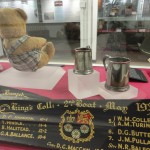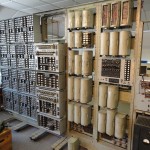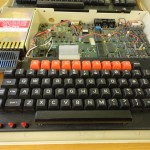See also this blogpost – and the photos above.
For every £40 spent by the UK state sector, nearly £1 goes on information and communications technology; well over twice what we spend on roads.
Yet just 70 years ago, the electronic programmable computing on which all ICT depends was just a theoretical concept in the minds of visionaries such as Alan Turing. Calculations were made by humans, sometimes with the aid of machines, but these were mechanical and electrical.
At Bletchley Park, a country house and estate by the train lines and communication cables from London to the north-west, the government employed Turing and his peers to turn the concept of electronic programmable computing into reality, in order to crack the sophisticated enciphering machines of the Nazis. The work, which some historians believe shortened the war by two years, was blanketed in secrecy, and remained undercover for decades afterwards.
No longer. “Bletchley: Home of the codebreakers,” reads the town sign. Pointers to Enigma Court, a new housing development named after the most famous enciphering equipment broken by the park, appear miles earlier.
Bletchley Park is now a collection of museums which show how rapidly computing developed during the desperate years of war. In September 1940, former university student Mavis Lever used pencil and paper to make a key breakthrough in cracking Italy’s naval cipher, contributing greatly to Britain’s first major naval victory in the war, when it sank five Italian ships at Cape Matapan on 28 March 1941.
To crack the Enigma field cipher machines, in March 1940, based on a design by Turing, the park introduced ‘bombes’, electro-mechanical machines that hugely speeded the checking of possible combinations after cryptanalysts had narrowed these down. The cryptanalysts prepared ‘menus’ – what they thought might be parts of the Enigma settings for the day – and the bombes ran the missing elements until (or if) they found a match.
Now, a rebuilt bombe clatters away on the ground floor of the park’s main museum, just past the largest public collection of Enigmas and Alan Turing’s trousered teddy bear Porgy. But as a sign makes clear, the bombe is not a computer.
Colossus is. A recreation of the world’s first electronic semi-programmable computer fills much of a room at the National Museum of Computing, in Block H at the edge of the park.
It took engineer Tommy Flowers 11 months to build the first Colossus at the Post Office research station at Dollis Hill in London, and is thought to have attacked its first message at Bletchley on 5 February 1944, looking for combinations used by Nazi Lorenz machines used to encipher teleprinter traffic (generated by machine, unlike the hand-tapped Morse code used to send Enigma messages). A second version went online just before D-Day, contributing to the 18,000 messages a day the park deciphered in the weeks following.
After the war, the Colossi were used by the London forerunner of GCHQ, and remained secret until the 1970s. It has taken the museum nearly 15 years to rebuild one, on the site of the ninth original machine acquired by Bletchley Park.
While a Colossus has been reconstructed, the museum’s Witch is the real thing. Later this year, the museum hopes to reanimate the Harwell Dekatron, later renamed the Wolverhampton Instrument for Teaching Computer from Harwell, which it believes will become the world’s oldest working extant computer. The machine, already on show at the museum, was built in 1949 for the Harwell atomic power station in Oxfordshire.
“Its job was almost mundane – to produce mathematical tables,” says trustee Kevin Murrell, a job that had previously fallen to teams of luckless graduates. In 1957, a college in Wolverhampton won a competition to take it on, and used it for many years, with local firm Chubb borrowing it to design key patterns. In 1973 it went to Birmingham’s science museum, where Murrell saw it in as a teenager. Years later, he recognised its control panel in a photograph taken of something else by a colleague in a museum store. Later this year, Murrell hopes to reunite Witch’s three designers, all of whom are still alive.
As well as sheer age, the six foot high, nine foot long Witch is a fascinating machine. It uses Dekatrons made by Ericsson to calculate in decimal, rather than the binary transistors used by virtually all computers since. Its 90 ‘stores’ (rows of Dekatrons) can each store eight 0-9 digits – equivalent to about 3 kilobytes of binary data – and each digit is visible through the position of a yellow light within each Dekatron.
Having covered UK government’s first uses of computing for military and research purposes, the museum also commemorates its first municipal use – in Norwich. In 1957 the city treasurers department spent £37,000 on an Elliott 405, with the option of an 80% discount if it returned it within a year. The museum has photos of deliverymen in white coats moving Fred (fiendishly rapid electronic device), higher than the men and covered with a drape reading ‘Elliott Electronic Computer’, down from a truck and towards a worryingly small door.
And it has a later Elliott 803 among its collection, which is merely the size of several desks, with 16k of core memory in an eight-inch cube of metal and a further megabyte on a spool of familiar looking tape – it is magnetised 35mm Kodak camera film. When the museum’s machine has successfully loaded software, it plays a tune to show it is working.
Elliott, a British firm, also spawned the UK’s first software house – when programmer Dina St Johnston, who had written the applications for the Norwich treasurers computer, left the firm to start a family, and in 1959 set up Vaughan Programming Services. The firm continued independently until 1996.
The museum has numerous other treasures: an 8Mb three-foot wide hard disk that has recently served as a novelty coffee table; an Ericsson air traffic control screen installed in 1978 at West Drayton which needed two separate computers to run it; a five foot high black Cray Y-MP EL supercomputer with a massive red ‘click here to launch the missiles’ button on its top; and a Marconi computer the size of several large wardrobes, which used its 8k of memory to help run a nuclear power station at Wylfa on Anglesey from 1961… until 2004.
A room dedicated to personal computers has the feel of a Curry’s in a time-warp, with items such as a 1984 Apple Mac (128k for a cost of £1,600) and a Sinclair ZX81 (1k, but just £70 ready-assembled).
There is also a wealth of products from Acorn, which fought its compatriot Sinclair to dominate British home computer manufacturing in the mid-1980s, including an entire room of working BBC Micros. The machines, built to the corporation’s specifications to accompany its IT education work, were bought by most schools. The museum’s learning co-ordinator Chris Monk used to teach in a room like this – and is now doing so again, with groups from schools, colleges and universities who are studying ICT skills or computer science, but are unused to computers that encourage – in fact, insist – users to program them.
Monk says the BBCs, which when switched on are instantly ready to accept Basic computer code, were a great way to introduce students to programming. “It’s very accessible,” he says. “You couldn’t hurt it. You couldn’t damage it. You couldn’t go onto the internet and see stuff you shouldn’t see.” Groups now are encouraged to get a taste by typing in short programs from books, then messing about with them. Currently, Monk’s education groups have a ratio 25 boys to each girl: the museum is planning to offer days for primary schoolchildren, partly with the hope of interesting girls in coding.
The museum also accepts corporate groups, and recently entertained British chip designer ARM – which was spun out of Acorn to exploit the low-power chip it had designed. Acorn made its last computer, the Phoebe, in 1998 (on show here), but ARM dominates its global market, with chips in the vast majority of mobile devices sold. Hermann Hauser, one of Acorn’s founders, is another recent visitor.
The museum relies on donations, of time, money – and exhibits. Would it welcome any ancient hardware from the British state sector, which less than 70 years ago started it all off in this very building? Murrell says firmly: “We would welcome the option.”
* The National Museum of Computing is usually open on Thursdays and Saturdays and for guided tours on Tuesdays: check website for details. The rebuilt Colossus is open daily and is included in guided tours of Bletchley Park.
This article is published by Guardian Professional. For weekly updates on news, debate and best practice on public sector IT, join the Guardian Government Computing network here.
guardian.co.uk © Guardian News & Media Limited 2010
Published via the Guardian News Feed plugin for WordPress.



